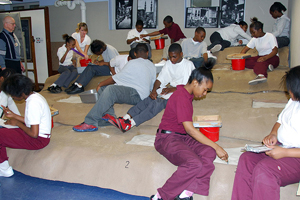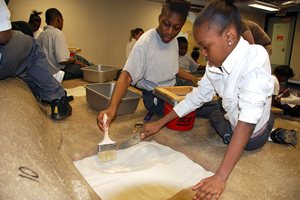Kipper center encourages children to investigate field of archaeology
By William Harmsw-harms@uchicago.edu
News Office
 Photos courtesy of the Oriental Institute A group of school children visit the new Kipper Family Archaeological Discovery Center at the Oriental Institute. Like the mounds that archaeologists excavate in the Middle East, the children are able to discover replicas of ancient artifacts buried within the centerís simulated dig site, using the same techniques archaeologists apply in their fieldwork. |
|
 |
|
Chicago-area students will get some hands-on experience now that the Oriental Institute has opened its new Kipper Family Archaeology Discovery Center, where children can make their own discoveries in a simulated archaeological dig.
The Archaeology Discovery Center, which opened Monday, Nov. 17, will allow visiting school children to recover archaeological replicas buried in an artificial ancient mound, known as a “tel.” Oriental Institute archaeologists, whose expeditions take them across the Middle East, often dig for artifacts in these ancient mounds.
“Giving school children the opportunity for hands-on excavation is fundamental to the mission and future of the Oriental Institute,” said Gil Stein, Director of the Oriental Institute. “It will give visitors a more direct experience with archaeological discovery, not only significantly enhancing what they learn, but also giving them a strong personal connection with archaeology and with the ancient Near East.”
The artificial site was constructed at the Oriental Institute using a collapsible metal frame and Fiberglass. “We used a concoction of sand, gravel and epoxy to create a pebbly, solid surface upon which students can climb,” said Erik Lindahl, Museum Preparator, who oversaw the project.
The Archaeology Discovery Center is aimed at sixth-grade students, who make up most of the school groups visiting the museum, and it will have an emphasis on serving teachers and students in metropolitan schools. In the future, the Discovery Center could become a springboard for a wide variety of programs and services that will serve families, youth, educators and special-needs audiences throughout Chicago and beyond.
“In the Kipper Center, visitors will use real tools to excavate trenches based on Oriental Institute excavations at Megiddo. They will find reproductions of artifacts, including oil lamps, jewelry, pottery shards, and human and animal figurines,” said Geoff Emberling, Director of the Oriental Institute Museum. “They can then explore how archaeological finds literally make history and learn from group discussions about the significance of these artifacts.”
To prepare a program for the students, Carole Krucoff, Head of Public and Museum Education, worked with students from the Master of Arts Program in the Social Sciences assembled by Morris Fred, an instructor in the program and former Director of the Spertus Museum. The team also consulted Susan Bass Marcus, educator emerita at the Spertus Museum and former curator of the ARTiFACT Center.
Also joining the project were the Oriental Institute’s Wendy Ennes, Teacher Services and E-Learning Coordinator, and Jessica Caracci, Museum Education Assistant, who helped develop learning materials, including a comic book-style guide for teachers, field notebooks and trench cards.
The new center builds upon the acclaimed work of the Rosenbaum ARTiFACT Center at the Spertus Museum, which was not reinstalled when the museum moved last year.
The Oriental Institute’s new center is named for Chicagoans David and Barbara Levy Kipper. David Kipper is a clinical psychologist who served as an adjunct faculty member and Senior Research Associate in the School of Social Service Administration. He currently teaches at Roosevelt University. Barbara Levy Kipper is former chair of the Spertus Board of Trustees.
![[Chronicle]](/images/sidebar_header_oct06.gif)